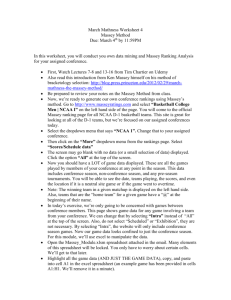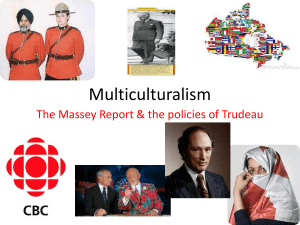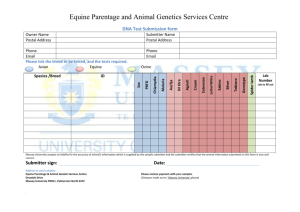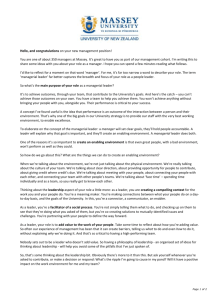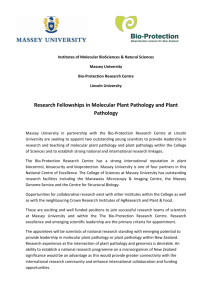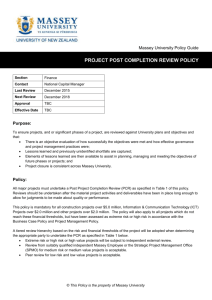Free sample of Solution Manual for
advertisement
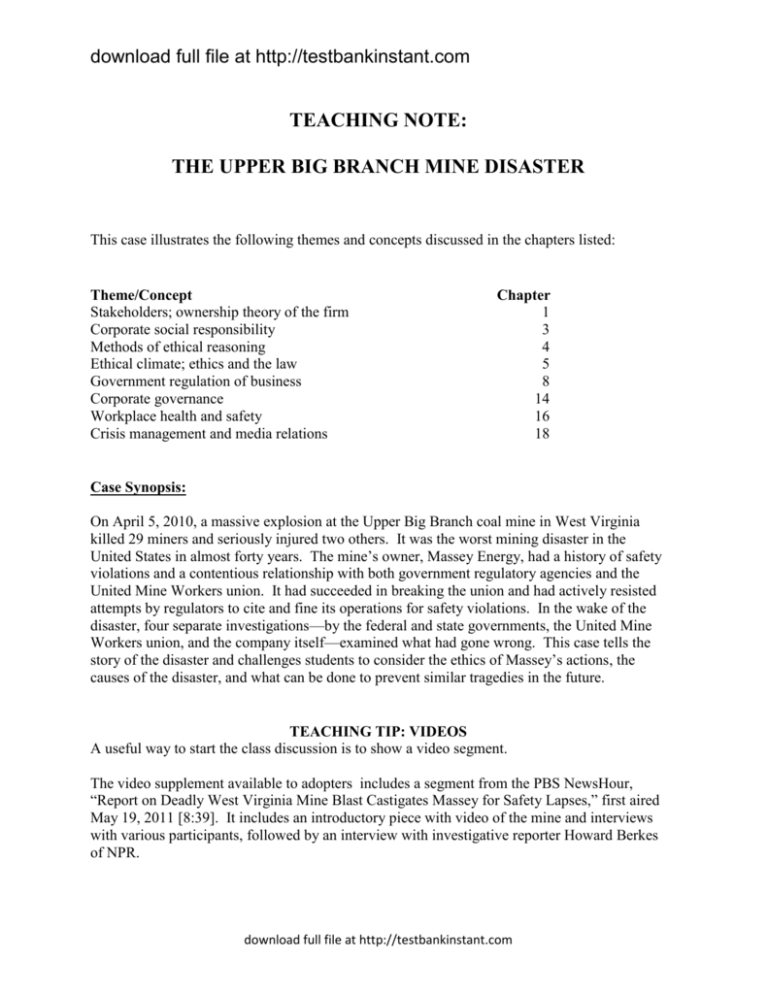
download full file at http://testbankinstant.com TEACHING NOTE: THE UPPER BIG BRANCH MINE DISASTER This case illustrates the following themes and concepts discussed in the chapters listed: Theme/Concept Stakeholders; ownership theory of the firm Corporate social responsibility Methods of ethical reasoning Ethical climate; ethics and the law Government regulation of business Corporate governance Workplace health and safety Crisis management and media relations Chapter 1 3 4 5 8 14 16 18 Case Synopsis: On April 5, 2010, a massive explosion at the Upper Big Branch coal mine in West Virginia killed 29 miners and seriously injured two others. It was the worst mining disaster in the United States in almost forty years. The mine’s owner, Massey Energy, had a history of safety violations and a contentious relationship with both government regulatory agencies and the United Mine Workers union. It had succeeded in breaking the union and had actively resisted attempts by regulators to cite and fine its operations for safety violations. In the wake of the disaster, four separate investigations—by the federal and state governments, the United Mine Workers union, and the company itself—examined what had gone wrong. This case tells the story of the disaster and challenges students to consider the ethics of Massey’s actions, the causes of the disaster, and what can be done to prevent similar tragedies in the future. TEACHING TIP: VIDEOS A useful way to start the class discussion is to show a video segment. The video supplement available to adopters includes a segment from the PBS NewsHour, “Report on Deadly West Virginia Mine Blast Castigates Massey for Safety Lapses,” first aired May 19, 2011 [8:39]. It includes an introductory piece with video of the mine and interviews with various participants, followed by an interview with investigative reporter Howard Berkes of NPR. download full file at http://testbankinstant.com download full file at http://testbankinstant.com As an alternative, instructors may wish to use “A Preventable Event: The Story of the Upper Big Branch Mine Disaster,” first aired May 20, 2011 [9:39] on the PBS “Need to Know” program. It is available on streaming video: http://www.pbs.org/wnet/need-to-know/video/video-a-preventable-event-the-story-of-theupper-big-branch-mine-blast/9454/ For instructors who wish to use a more comprehensive report, “In the Coal: The Upper Big Branch Disaster” [December 10, 2010; 19:06] is available on streaming video: http://www.pbs.org/wnet/need-to-know/video/in-the-coal-the-upper-big-branch-disaster/5704/ Instructors wishing to explore the issue of mountaintop removal mining in greater depth may show excerpts from “The Last Mountain,” a documentary by Bill Haney (released November 1, 2011), available in DVD format from Amazon. Various short videos of Don Blankenship are available on YouTube, including one showing a run-in with a journalist and another in which he explains why nonunion mines are more costefficient. Summary of Discussion Questions 1. What were the costs and benefits to stakeholders of the actions taken by Massey Energy and its managers? 2. Applying the four methods of ethical reasoning (utilitarianism, rights, justice, and virtue), do you believe Massey Energy behaved in an ethical manner? Why or why not? 3. Who or what caused the Upper Big Branch Mine disaster, and why do you think so? 4. What steps could be taken now to reduce the chances of a similar tragedy occurring in the future? In your answer, please address the appropriate roles of mining companies (and their directors and managers), government regulators and policymakers, and the workers and their union in assuring mine health and safety. Discussion Questions and Answers 1. What were the costs and benefits to stakeholders of the actions taken by Massey Energy and its managers? Instructor may wish to work through a board grid, in which stakeholders are listed on the left and the costs and benefits to each are listed in two side-by-side columns, as illustrated below. download full file at http://testbankinstant.com download full file at http://testbankinstant.com Stakeholder Don Blankenship Managers Board of directors Shareholders Employees Customers BENEFITS COSTS/RISKS $129 million over ten years in compensation Use of a corporate jet, cars, and other perks Social status Power over others Relatively high pay and status in a low-income region At least $130,000 per year in compensation for a few days of meetings Referred to himself as “vilified;” apparently widely disliked in the community and by his own employees Mediocre returns during the 2000s, but not much different from industry averages For some, a relatively highpaying job in a low-income region Local community Union (UMW) Government regulators A steady supply of highquality, relatively low-cost fuel for steel, utility, and industrial customers For utility customers: a steady supply of relatively low-cost electric power from coalfueled power plants Some jobs, some taxes, some philanthropic support Benefits to the broader community of energy independence None Massey’s flagrant disregard for compliance may have contributed to greater allocation of funding and positions to the regulatory agencies Demanding boss, stressful job Reputational risk due to association with a company with a poor reputation for environmental impacts and worker safety High volatility, high risk investment Unsafe job; high risk of illness, injury, or death Intimidating, threatening workplace culture Lack of union protection For some: a violent, sudden death by incineration or suffocation For some: the trauma of experiencing the death or injury of friends and coworkers For the families of victims: loss of a loved one Risk of supply interruption from a supplier with high safety and environmental risks Water and air pollution Environmental degradation Highly effective anti-union strategy; declining membership Harassed, deceived and thwarted by Massey management in their efforts to enforce the law download full file at http://testbankinstant.com download full file at http://testbankinstant.com Environment None Widespread damage to ecosystems and watersheds due to mountaintop removal mining Coal sludge spill TEACHING TIP: OWNERSHIP THEORY OF THE FIRM The ownership theory of the firm, discussed in Chapter 1, prioritizes the maximization of shareholder value above all other considerations. Evidence in the case suggests that the board of directors and top managers of Massey subscribed to this view; they appear to have been singularly focused on shareholder returns (e.g., the board stated that the goal of the compensation system was to motivate executives to “achieve continuous improvements in company-wide performance for the benefits of our stockholders.”) Yet, the company did not do a particularly good job of achieving this goal: shareholder returns in the years preceding the disaster were mediocre, and were in any event no better than the returns for the coal industry as a whole. Arguably, Massey took high environmental and safety risks without offsetting benefits to shareholders. 2. Applying the four methods of ethical reasoning (utilitarianism, rights, justice, and virtue), do you believe Massey Energy behaved in an ethical manner? Why or why not? Instructor prompt: Would a utilitarian find Massey Energy’s actions to be ethical? TEACHING TIP: UTILITARIANISM The textbook (Chapter 4) defines utilitarianism as follows: [Utilitarian reasoning] emphasizes utility, or the overall amount of good that can be produced by an action or a decision… It is often referred to as cost–benefit analysis because it compares the costs and benefits of a decision, a policy, or an action… These costs and benefits can be economic (expressed in dollar amounts), social (the effect on society at large), or human (usually a psychological or emotional impact). After business managers add up all the costs and benefits and compare them with one another, the net cost or the net benefit should be apparent. For a utilitarian, the alternative where the benefits most outweigh the costs is the ethically preferred action because it produces the greatest good for the greatest number of people in society. The instructor may wish to build on the discussion of costs and benefits to stakeholders (Question 1) to help students formulate an answer to this question. A utilitarian could argue this case either way. Some would conclude that the benefits (ends, or results) of Massey’s actions did not justify the costs (means). In this view, the means (high rates of injury, illness and death; environmental degradation; union-busting; open violation of the safety and health and environmental laws) did not justify the ends (employment for about 6,000 people in a relatively poor region; relatively cheap coal for industrial customers; and relatively cheap electric power for many utility customers.) A utilitarian might come to the download full file at http://testbankinstant.com download full file at http://testbankinstant.com opposite conclusion if he or she weighed cheap energy and energy independence more highly and viewed the Upper Big Branch disaster as an anomaly. Instructor prompt: Were any human rights violated by Massey’s actions? TEACHING TIP: RIGHTS This prompt asks students to apply the theory of rights to the case. The textbook (Chapter 4) defines this theory as follows: Human rights are another basis for making ethical judgments. A right means that a person or group is entitled to something or is entitled to be treated in a certain way… The most basic human rights are the rights to life, safety, free speech, freedom, being informed, due process, and property, among others. Denying those rights or failing to protect them for other persons and groups is normally considered to be unethical. Respecting others, even those with whom we disagree or dislike, is the essence of human rights, provided that others do the same for us. This approach to ethical reasoning holds that individuals are to be treated as valuable ends in themselves just because they are human beings. Using others for your own purposes is unethical if, at the same time, you deny them their goals and purposes. Yes, Massey’s actions violated human rights. Massey put the health and very lives of its employees at risk through its deliberate disregard for accepted standards of mine safety. It jeopardized the property rights and health of community members impacted by mountaintop removal mining. It intimidated its own employees, robbing them of the right to speak their minds freely about their concerns about their coworkers’ and their own safety. Massey violated workers’ rights to organize a union when it violently and callously broke the United Mine Workers at its own facilities. The company as a matter of policy broke the law by violating government mine safety regulations, deceiving government inspectors, and contesting penalties imposed by regulators. TEACHING TIP: ETHICS AND THE LAW Students might be asked: Did Massey follow the law? As Chapter 5 explains, ethics and law are not the same, although they usually coincide. Most business ethicists believe that companies should follow the law as a minimum, but in many cases should go “beyond compliance” to achieve a higher standard of behavior. Yet, a striking feature of Massey’s behavior is the extent to which it appeared to deny the very legitimacy of the government over its actions. The company apparently viewed mine safety (and environmental) regulations as illegitimate, and actively sought to contravene these legal requirements. Massey’s behavior was not only unethical; it was also illegal. The company’s actions can, in this sense, be considered “rogue” or “outlaw.” download full file at http://testbankinstant.com download full file at http://testbankinstant.com Instructor prompt: Were Massey’s actions fair and just towards all those affected? TEACHING TIP: JUSTICE AND FAIRNESS This question asks students to apply the theory of justice and fairness to the case. The textbook (Chapter 4) defines this theory as follows: Justice, or fairness, exists when benefits and burdens are distributed equitably and according to some accepted rule. For society as a whole, social justice means that a society’s income and wealth are distributed among the people in fair proportions. A fair distribution does not necessarily mean an equal distribution. Most societies try to consider people’s needs, abilities, efforts, and the contributions they make to society’s welfare. Since these factors are seldom equal, fair shares will vary from person to person and group to group. Justice reasoning is not the same as utilitarian reasoning. A person using utilitarian reasoning adds up costs and benefits to see if one is greater than the other; if benefits exceed costs, then the action would probably be considered ethical. A person using justice reasoning considers who pays the costs and who gets the benefits; if the shares seem fair (according to society’s rules), then the action is probably just. Most students will argue that Massey’s actions were not fair. One individual benefitted enormously: the company’s CEO, Don Blankenship (and possibly other senior executives, although the case does not discuss this). Over the course of his career as CEO at Massey, Blankenship earned around $129 million and enjoyed many perks of his position. The burdens of Massey’s actions fell disproportionately on the workers, communities, and unions of central Appalachia. download full file at http://testbankinstant.com download full file at http://testbankinstant.com Instructor prompt: Were Massey’s actions “virtuous,” or reflective of good corporate character? TEACHING TIP: VIRTUE ETHICS This question asked students to apply the virtue ethics framework to the case. The textbook defines this theory as follows: [Virtue ethics] focuses on character traits that a good person should possess, theorizing that moral values will direct the person toward good behavior. Virtue ethics is based on a way of being and on valuable characteristics rather than on rules for correct behavior…. [Most] scholars believe that there is a great deal of agreement on the question of who is acting as the virtuous person, as summed up by business ethicist Manuel Velasquez: “An action is morally right if in carrying out the action the agent exercises, exhibits, or develops a morally virtuous character, [as opposed to] develops a morally vicious character.” When placing virtue ethics in a business context, ethicist Robert Solomon explains, “The bottom line of [the virtue] approach to business ethics is that we have to get away from ‘bottom line’ thinking and conceive of business as an essential part of the good life, living well, getting along with others, having a sense of self-respect, and being a part of something one can be proud of.” Although virtue ethics usually refer to an individual’s character, the concept can also be applied to an analysis of a company’s actions. Likewise, Massey’s actions do not pass the “virtue” test. Massey was animated by “bottom line thinking” and showed an almost complete lack of empathy for others. In sum, an application of the four methods of ethical analysis to this case demonstrates that Massey’s actions did not meet the standards of rights, justice, or virtue, and may or may not have met the standards of utilitarianism. TEACHING TIP: ETHICAL CLIMATE The instructor may wish to ask students to classify Massey according to the typology of ethical climates, as presented in Chapter 5. The textbook explains: The unspoken understanding among employees of what is and is not acceptable behavior is called an ethical climate… Three distinct ethical criteria are egoism (self-centeredness), benevolence (concern for others), and principle (respect for one’s own integrity, for group norms, and for society’s laws)… These ethical criteria can be used to describe how individuals, a company, or society at large approach various moral dilemmas. By this typology, Massey’s would probably be classified as “egoist,” that is, the company was primarily concerned with its own profits and the compensation of its senior executives; it showed little concern for others or for society’s laws. download full file at http://testbankinstant.com download full file at http://testbankinstant.com TEACHING TIP: FORMAL AND INFORMAL SYSTEMS Some theorists have pointed to the distinction between formal systems (stated policies) and informal systems (as set by a firm’s norms, climate, and managerial example). Ethics are strongest when both formal and informal systems are in alignment. One of the interest details of this case is that Massey apparently had a formal system (the “S-1, P-2” initiative) that placed safety first; but all its informal systems—such as the requirement to report production figures every 30 minutes to the CEO; the communications systems set up to warn underground managers of the arrival of government inspectors; and the infamous “RUNNING COAL” memo—seemed to contradict this. In other words, at Massey the formal and informal systems were not in alignment. 3. Who or what caused the Upper Big Branch Mine disaster, and why do you think so? Some students will answer this question by citing the sequence of physical events that occurred on April 5, 2010, that is: A poorly maintained longwall shearer in contact with sandstone caused a spark which it could not extinguish because of inoperative water sprayers; the spark ignited a pocket of methane gas that had been allowed to accumulate at the coal face because of poor ventilation; and the resulting explosion propagated throughout the mine because of an accumulation of flammable coal dust that had not been properly treated with rock dust. This answer would be correct, at least, according to the two government investigations and the union’s investigation. However, students should be prompted to consider the difference between the immediate cause of the explosion (a spark, a fuel source) and the responsible parties. Instructor prompt: What people or groups were most responsible for the Upper Big Branch disaster, and why do you think so? Students may answer this question in several ways. Among the possible responses are these: Don Blankenship: The case suggests that Blankenship had near-total control over Massey Coal Company, and later Massey Energy, for almost twenty years. During that time, he had decisive influence over the culture, policies, and practices of the firm. He directed a management system that gave priority to productivity—running coal—over all other considerations, including environmental impacts, worker health and safety, and legal compliance. As a hands-on manager, he was fully aware of everything that was going on in the company, down to the last tank of gasoline or ton of coal. Accordingly, he should bear the ultimate responsibility for the Upper Big Branch mine disaster. Students may note that Blankenship himself disavowed any responsibility for the disaster, telling analysts that his conscience was “totally clear.” download full file at http://testbankinstant.com download full file at http://testbankinstant.com The board of directors: The board of directors was responsible for the disaster because it deliberately set up a compensation system for their CEO that incentivized high earnings and productivity over other factors. Blankenship’s incentive-based compensation (stocks and option awards and incentive plan) comprised more than 86 percent of his compensation in 2009 (Exhibit A). His compensation plan (Exhibit B) based more than half (55 percent) of his incentive pay earnings on earnings and productivity-related factors (EBIT, produced tons, continuous miner productivity, surface mining productivity, and fulfillment of contracts). Percent reduction in environmental violations counted for 10 percent, and percent reduction in NFDLs for 10 percent. Arguably, the latter figure could be—and was—manipulated by the company by a deliberate policy of not recording miners’ injuries. Other factors (identification of successors, employee retention, and diversity of members) counted for 25 percent. Notably, there was no incentive for reducing fatalities. Arguably, Blankenship was doing exactly what the board wanted him to, that is, run as much coal as possible with only minimal regard for the costs to the environment and worker safety. The board put in place an incentive system that handsomely rewarded productivity—and then hired as CEO a trained accountant who was obsessed with numbers and seemed to have a complete lack of empathy for others. The result—a history of flagrant environmental and safety violations—was a predictable outcome. TEACHING TIP: A STUDENT/C STUDENT Average students will immediately recognize Blankenship’s responsibility for the disaster. However, only “A” students are likely to see the relationship between the structure of Blankenship’s compensation system and his behavior. TEACHING TIP: INDUSTRIAL HOMICIDE The case mentions that the United Mine Workers called the disaster “industrial homicide” and called for the criminal prosecution of Massey’s managers. As an assignment, students may be asked to determine if any precedents exist for such a prosecution of managers and if they think there would be a basis for such a charge. Government safety and health regulators: Another view is that the main responsibility lies with government regulators from MSHA and the corresponding West Virginia agency. Evidence in the case shows that inspectors were frequent visitors to the mine and issued repeated citations for violations of federal and state mine safety laws. However active the regulators were, they apparently did not use sanctions, up to and including shutting down the mine, that were sufficient to change Massey’s behavior. Policymakers: Some may argue that despite decades of legislative advances in the area of mine safety and health, the law was still too weak to effectively constrain the actions of rogue corporations like Massey. In this view, strong laws might have prevented the tragedy. download full file at http://testbankinstant.com download full file at http://testbankinstant.com The workers at Upper Big Branch: Many of the workers at Upper Big Branch appeared to be either intimidated by management, unaware of the danger in which they worked, or aware but resigned to acceptance of the conditions. For whatever reason, they had not effectively asserted their legal rights to organize a union. Some may argue that the workers were, in some sense, responsible for their own fate since they had not left the situation or effectively changed it. “God:” Finally, it is worth mentioning that the company’s view was that “God” was responsible for the disaster, because the explosion was caused by a sudden inundation of methane, an “Act of God” that they could not have anticipated or prevented. 4. What steps could be taken now to reduce the chances of a similar tragedy occurring in the future? In your answer, please address the appropriate roles of mining companies (and their directors and managers), government regulators and policymakers, and the workers and their union in assuring mine health and safety. TEACHING TIP: BOARD WORK One way to approach this question is to work across the board from “causes” to “possible remedies.” Another approach would be to look in turn at steps various parties could take, e.g., policymakers, management, etc. Students may wish to make a number of specific recommendations for change, including the following: Management selection and advancement: Boards of directors should select ethical managers and advance managers through the organization based on a proven track record of effectively balancing the requirements of profit and productivity with the legitimate interests of stakeholders and the need to comply with all relevant laws. Compensation systems: Boards of directors should design compensation systems that reward safe and environmentally sound operations (and apply penalties for noncompliance with the law). Legal compliance: Managers should make it clear that the policy of the corporation is to comply with the law and to go beyond compliance to achieve “best practice” health and safety systems. Safety should be given priority over production. Stronger protective legislation: The government needs to strengthen powers of regulatory agencies such as MSHA and West Virginia (office of mine safety) and give them sufficient authority to enforce their citations. Penalties for noncompliance should be strengthened, and flagrant violations should be felonies. Workers who report safety violations to government inspectors should be protected against retaliatory discipline. download full file at http://testbankinstant.com download full file at http://testbankinstant.com TEACHING TIP: CHANGING THE LAW As a separate assignment, students might be asked to research existing mine safety and health laws and recommend public policy changes that would help prevent an Upper Big Branch-like disaster in the future. Students may be interested in comparing their recommendations with that of a Senate working group that explored options for policy change following the UBB disaster. This document, titled “Proposed Legislative Changes to Protect the Safety of All Workers and Prevent Future Disasters,” may be found at: www.mshahelp.com/summary_proposal.pdf. Some of these recommendations later appeared in legislation introduced by Congressman George Miller of California. Labor laws: Strengthen the labor laws that enable fair, unbiased elections for union representation. Energy policy: Develop an energy policy that gives greater support to less polluting and less dangerous (for workers and the environment) sources of energy. Epilogue: As of December, 2012, the following further developments had occurred: In May 2011, Massey said it made a settlement offer of $3 million to each deceased miner's family, and seven families had agreed to its offer. Some other families refused the offer and pursued wrongful death suits against the company. Massey failed to make a profit in any quarter of 2010. After the investigations of the disaster had been completed, Massey permanently sealed the Upper Big Branch mine. Various institutional investors sued Massey for damages. Congressman George Miller introduced legislation in late 2010 that would make it harder to companies to use the appeals process to delay or avoid enforcement action. The proposed law would also increase penalties for violations, protect employee whistle-blowers, and protect the pay of workers who were out of work when violations led to a mine closure. The law would also empower regulators to obtain a court order to close an unsafe mine. The law failed in 2010 and was reintroduced the following year. In December 2010, CEO Don Blankenship stepped down as CEO of Massey. download full file at http://testbankinstant.com download full file at http://testbankinstant.com In January 2011, Alpha Natural Resources purchased Massey for $7.1 billion. Almost all of Massey’s and Alpha’s shareholders voted to approve the acquisition. As part of the agreement, Don Blankenship received a severance of $86 million. Massey’s nonemployee directors received payments ranging from $1.2 million to $4.9 million. Alpha Natural Resources publicly repudiated the Massey report that blamed the disaster on a sudden, unexpected inundation of natural gas through a crack in the floor. In late 2011, Blankenship filed papers to open a new mining company, located in Belfry, Kentucky, to be called the McCoy Coal Group Inc. (presumably named after his mother’s ancestors). In January 2012, Alpha settled with the families of victims (who had not already settled with Massey). Terms of the settlement were not revealed. In late 2011, Hughie Stover, a former security officer, was convicted of lying to investigators looking into the causes of the disaster; he was later sentenced to three years in prison. In March 2012, a former superintendent of the mine, Gary May, pleaded guilty to conspiring to “impede the Mine Safety and Health Administration's enforcement efforts” at the Upper Big Branch mine. May admitted he had given advance warning of inspections and concealing safety violations. In November 2012, David C. Hughart, formerly president of a division of Massey Energy, pleaded guilty to one felony count of conspiracy to defraud the United States and agreed to cooperate with prosecutors. Some thought that prosecutors were using Hughart’s cooperation as a way to build a case against higher-up officials at Massey. “I think it’s an indication that they’re aiming higher in the chain of command,” said one lawyer quoted in the New York Times. download full file at http://testbankinstant.com
